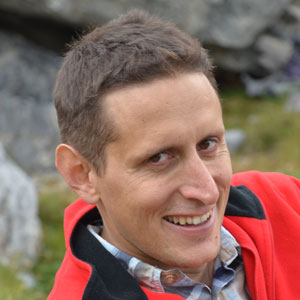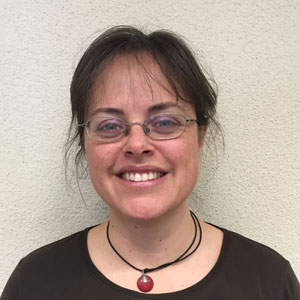Our body is composed of billions of cells, each of them achieving a specialized task. For example, our flat skin cells ensure protection from external physical and chemical aggressions whereas our rod-like photoreceptor cells in the eye allow light to be sensed in our environment. Despite this variability in structure and function, almost all cells in our body have exactly the same genome, the DNA sequence where our genetic information is stored. As an analogy, one could think of the genome as the hard disk of a computer, where every program for each cell type is stored but in each cell only one of these programs is executed.
The genome is physically separated from the rest of the cell within a specialized organelle, the nucleus. A high level of compaction is achieved: our genome is 2 meters long but stored in a ball of a diameter of 5 micrometers (the nucleus). This would correspond to a very thin wire the length of the distance from Zürich to Geneva stored within a basketball. The compaction of this wire is, however, neither homogenous nor constant: some regions of the genome are very densely wrapped while others are looser. This compaction level along the wire, as well as the spatial distribution of the genome (where a given segment of the wire is located inside the nuclear ball) is unique to each cell type and setup when cells acquire a specialized function. Moreover, mutations in structural components of the nucleus have been shown to be linked to a number of diseases. These point to the importance of the organization of the genome in space inside the nucleus.
The organism which we use for these studies is the roundworm C. elegans. This simple animal is found in our gardens on rotting fruits, its fast life cycle (3 days) makes it an ideal laboratory model. It is one of the best-known organisms in which individual different cells achieve specialized tasks (as the skin or photoreceptor cells). Since much of the machinery involved in organizing the genome in 3 dimensions is evolutionarily conserved, the knowledge gained in the roundworm will improve our understanding of the gene expression.
Synchronous embryonic development of C. elegans embryos
On one hand, we study the dosage-compensated X chromosome which expression is adapted to the X:autosome ratio. We discovered that this chromosome forms sex-specific nuclear domains: in males it lies in a pore-proximal territory while in hermaphrodites the dosage compensation complex (DCC) prevents this localization. We are now exploring how these domains are formed and maintained and their impact on gene expression. The DCC is a structural maintenance of chromosome (SMC) complex, which delimitate epigenetic and topological domains. Unlike other SMC complexes, the DCC has no essential mitotic role and our experimental system opens new perspectives to interrogate how the formation itself of topologically associated domains by SMC complexes regulates transcription.
On the other hand, we interrogate the epigenetic determinants of cell fate robustness, using a single cell readout plasticity sensor based on transcription factor-induced transdifferentiation. Using this system, we are able to identify a single transdifferentiating cell in vivo using intact animals.

| Current | |||||
| Peter Meister (FR) | Group Leader |  |
|||
| Jennifer Semple (CH/UK) | Laboratory manager |  |
|||
| Will Smith (UK) | PhD student | ||||
| Valeryia Aksianiuk (US/BY) | PhD student | ||||
| Kalyan Ghadage (IN) | PhD student | ||||
| Dario Bernasconi(CH) | PhD student | ||||
| Sinem Erkan(TR) | PhD student | ||||
| Alumni | |||||
| Iris Suter(CH) | Master student | ||||
| Anja Haemmerli (CH) | Master student | now trainee, IFIK, Bern, Switzerland | |||
| Jaime Osuna-Luque (ES) | PhD student | now Inside Sales Representative, Takara Bio Europe, St-Germain-en-Laye, France | |||
| Bolaji Isiaka (-Lüthi) (NG) | PhD student | now project leader QC, Lonza Visp, Switzerland | |||
| Moushumi Das (IN) | PhD student | now post-doc, Steiner lab, Geneva, Switzerland | |||
| Valeriia (Lera) Volodkina (RU) | PhD student | ||||
| Todor Gitchev (BG) | Master student | now senior research software engineer, Krauthammer lab, Zürich, Switzerland | |||
| Ahrmad Annan (F) | Master student | now PhD student Ciriello lab, Lausanne, Switzerland | |||
| Janik Scotton(CH) | Master student | now PhD student Simonini lab, Zürich, Switzerland | |||
| Julie Campos (FR) | Laboratory manager | now technician at Invivogen, Toulouse, France | |||
| Sonia Karaz (FR) | Laboratory manager | now laboratory manager in the Feige laboratory, Lausanne | |||
| Ringo Püschel (DE) | PhD student | now Process Technology Senior Engineer, CSL Behring, Bern, Switzerland | |||
| Rahul Sharma (IN) | PhD student | now Team Leader at Myllia Biotechnology, Vienna, Austria | |||
| Niels Rinzema (NL) | Master student | now post-doc at Stadhouders lab, Erasmus MC, Rotterdam | |||
| Abdulaziz Jaber (SA) | MSc student | now Scientist II at Roche Diagnostics, Auw, Switzerland | |||
| Francesca Coraggio (IT) | PhD student | now Associate Researcher, Goncalvez laboratory, DKFZ Heidelberg, Germany | |||
| Alisha Marti (-Grendelmeier) (CH) | MSc student, lab injection specialist | now Technical Owner lentivirus and CAR-T at Janssen Vaccines, Johnson & Johnson, Bern, Switzerland | |||
| Thomas Gfeller (CH) | MSc student | now Sr Team Lead GMP Operations at Janssen Vaccines, Wohlen bei Bern, Switzerland | |||
| Adriana Gonzalez-Sandoval (MEX) | Post-doc | now Principal Technical Development Scientist at Genentech, South San Francisco, USA | |||
| Dominic Ritler (CH) | Master student | now Scientific associate, Canton Basel-Landschaft, Switzerland | |||
| Fiona Daly (CH) | Master student | now Principal Scientist at CSL Behring, R&D, Bioprocess Development, Bern, Switzerland | |||
Undergraduates training positions
Contact directly Peter Meister
Group activities